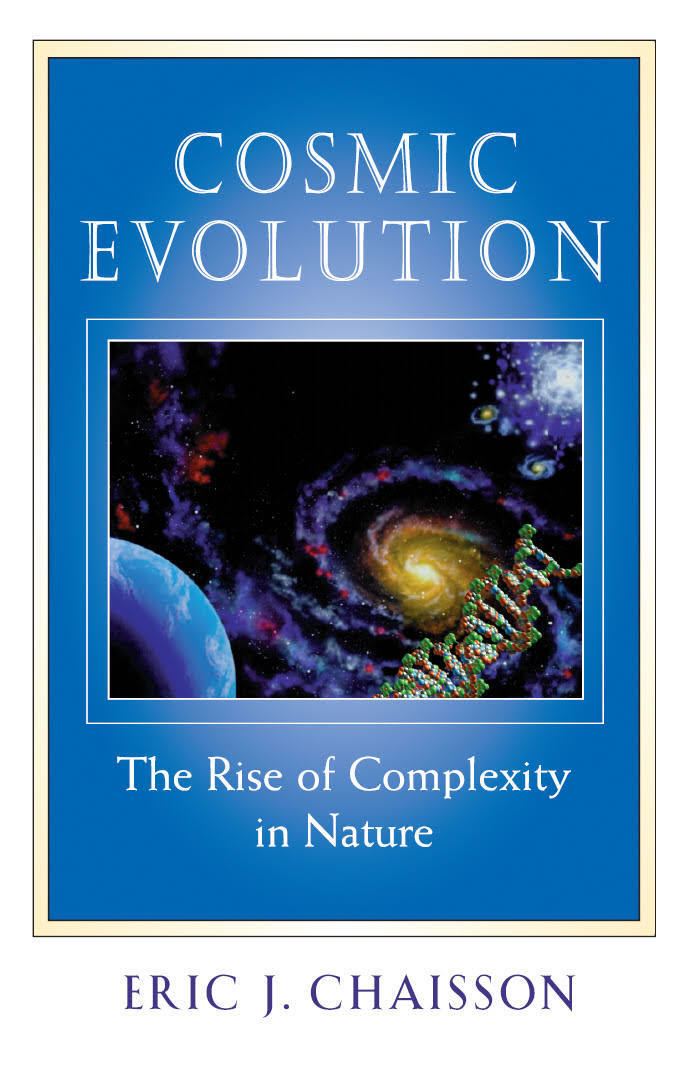8.6 /10 1 Votes8.6
Originally published 2001 | 4.3/5 Goodreads | |||||||||||||||||||||||||||||||||
 | ||||||||||||||||||||||||||||||||||
Similar Eric Chaisson books, Astronomy books | ||||||||||||||||||||||||||||||||||
Cosmic Evolution: The Rise of Complexity in Nature (2001) is a book by Harvard astrophysicist Eric Chaisson. It examines cosmic evolution which includes the history of natural evolution from the Big Bang to the present from the perspective of the emerging multi-scientific discipline of Big History. It offers an explanation of why simple structures billions of years ago gave way to more complex structures, such as stars, planets, life, and human beings in complex civilizations. It is written for a general audience interested in science.
Chaisson argues that cosmic history can be examined from the perspective of energy flows. He analyzes the flows of energy through various objects, and argues that these flows are relevant to understanding the relative complexity of these objects. He suggests that a key measure for scientific analysis should be energy per second per gram, termed "energy rate density," and that analysis using this yardstick can be used to explain not only human evolution but cosmic evolution. He sees energy as "work per unit time" which he equates with power, and shows how energy rate density in some structures has increased over time. For example, in Chaisson's view, the human brain uses a much greater amount of energy, relative to its size, than a galaxy. He suggests that energy lets us make "order out of disorder"; for example, an air conditioner, which draws current from an electric outlet, can turn a less-complex zone of lukewarm air into two more-complex zones of hot air and cold air, and in so doing, it reverses the disorder in a room. According to his view, organisms do much the same thing with energy but in a more complex way, by taking in food instead of electrons, to keep themselves from disintegrating and becoming less complex; he analyzes energy flows in not just organisms and society, but in inanimate structures such as stars, galaxies, planets.
Chaisson asserts that increases in complexity are consistent with the second law of thermodynamics; according to one reviewer, the second law might suggest that complexity should decrease with the universe "slouching toward disorder." However, Chaisson argues that complexity can increase because complex structures such as a star can "generate and sustain complexity by exporting enough disorder to its surrounding environment to more than make up for its internal gains." From this perspective, Chaisson offers a definition of life as an "open, coherent, space-time structure maintained far from thermodynamic equilibrium by a flow of energy through it."
Reactions to Chaisson's book are generally positive, although different reviewers took issue with some of his points and writing style. Biologist Daniel W. McShea originally noted that Chaisson is "prone to using inflated language," but a decade later in another review of his work notes that "Chaisson offers data showing a trend in what he calls energy rate density ... over the history of life (and even over the much longer history of the universe), that's really saying something." Critic Stewart Kauffman found the book to be a "wonderful discussion." Critic Hillel Braude wrote "Cosmic Evolution draws from a rich scientific palette to paint a colorful explanatory model of the ascending complexity in nature." Critic Charles Seife wrote highly about Chaisson's book although he criticized Chaisson's definition of life as being "such a broad definition" that it becomes meaningless, while acknowledging that Chaisson's analysis "gives the theory some numerical muscle." Many more excerpts from reviews of this book are collected here
Choice of units
Chaisson chose to use the cgs (centimetre, gram, second) system of measurement, rather than SI units as is standard current practice, for his calculations and numerical estimates - thus quoting energy in ergs (one ten millionth of a Joule), also using calories, and sometimes kilocalories as alternative measures of energy.
The English, or Imperial, system of units is obsolete in science and only metric units are used in today's scientific community. Editors, journalists, and students tend to use the Scientifique Internationale (SI) metric system, whereas many working scientists prefer the centimeter-gram-second (cgs) metric system. For example, astronomers almost always express luminosity in the cgs system's ergs per second; geologists typically use grams per cubic centimeter for density, and chemists often report gas flows in units of centimeters per second. Medical researchers almost entirely avoid the SI system, as do physical scientists specializing in thermodynamics, particle physics, astrophysics, and many other specialties. More than half a century after SI units became standard, widespread resistance to their use exists in many areas of science today.
This book, Cosmic Evolution, compiles data from many different areas of natural science, each with its own specialized metric units (and sometimes lingering non-metric units). To be fair and to allow easy comparison of energy, mass, energy flow, among other quantities characterizing complex systems, Chaisson converts consistently and uniformly those disparate units into the cgs-metric system most commonly and widely used by scientists actually doing research.
